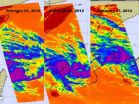(Press-News.org) A striking discovery in the study of human genetics was the focus of the most-visited press release posted on EurekAlert! in 2011. Researchers found that part of the non-African human X chromosome came from Neanderthals, confirming that they interbred with early human populations.
Breakthroughs in mathematics, physics, chemistry, and medicine, along with discoveries in zoology, psychology, and astrobiology, were also featured in the 10 releases most often viewed by EurekAlert! readers in 2011.
Website statistics collected over the course of the year identified the year's 10 most-visited news releases. The No. 1 most-visited press release garnered over 102,000 views.
The (love) connection between early humans and Neanderthals described in 2011's most-visited news release
Researchers from the University of Montreal and the CHU Sainte-Justine Research Center answered a nearly 10-year-old question concerning the origin of a part of the human X chromosome that shows characteristics different from the rest of the chromosome.
Using the Neanderthal genome, which was sequenced in 2010, to compare with the human genome, researchers found a match. The mysterious piece of the human X chromosome's sequence matches the Neanderthal's. From this, the researchers conclude that all non-African humans are in part descended from Neanderthals.
The finding was published in Molecular Biology and Evolution.
Uncovering new ground in medical and health sciences
Major advances in the health and medical sciences again drew significant attention from EurekAlert! readers in 2011.
In the tenth most-visited press release, Carnegie Mellon researchers replicated the hemoglobin protein from woolly mammoths. Their work may assist in developing blood products for people undergoing surgery-induced hypothermia, making such medical procedures safer.
The Mayo Clinic reported on a new therapy for individuals with multiple myeloma, a bone marrow cancer, in the fourth most-visited press release of 2011. Researchers found that the drug thalidomide, which caused birth defects when it was first used by pregnant women suffering severe morning sickness, is effective in treating multiple myeloma tumors in some patients. The finding opens up a new avenue for exploring personalized treatment options for myeloma patients based on biomarkers.
News releases on psychology studies were the ninth and sixth most heavily trafficked stories.
A study on meditation posted by Massachusetts General Hospital was the ninth most-viewed release. It showed that regularly practicing meditation not only makes people feel better, but it also physically alters parts brain that control stress, memory, self-awareness, and learning.
The article's first author, Britta Hölzel, Ph.D., said, "It is fascinating to see the brain's plasticity and that, by practicing meditation, we can play an active role in changing the brain and can increase our well-being and quality of life."
In the sixth, a researcher explores the root of that all too familiar experience of walking from one room to another and forgetting what it is you were going to do. In a study published in the Quarterly Journal of Experimental Psychology, a University of Notre Dame professor conducted experiments that demonstrate how the brain interprets moving between rooms as "event boundaries," thus making it difficult to recall memories even if they are only recently stored.
Novel research from the many and varied realms of science
The remainder of the 10 most-viewed stories of 2011 represents a variety of disciplines, including math and physics.
The seventh and eighth most-visited releases concern technological advances at the intersection of chemistry and physics. The eighth most-viewed release deals with "invisibility cloaking." It details work by assistant professor Yaroslav Urzhumov of Duke University. He applies invisibility cloaking principles that involve covering objects moving through water, such as ships, with a sponge-like coating equipped to push water out and away from the vessel. He posits that doing so could make water travel more energy efficient.
Ludovico Cademartriri, Ph.D., from Harvard University reports on his "electrical wave blaster" designed to fight fires in the seventh most-viewed story. "Controlling fires is an enormously difficult challenge. Our research has shown that by applying large electric fields we can suppress flames very rapidly," Cademartriri said. He and his team presented the device at the 241st American Chemical Society National Meeting and Exposition in March 2011.
The journal ZooKeys published an article on the discovery of the world's smallest frog species, which is the focus of the fifth most-viewed press release. The tiny frogs from the genus Paedophryne were found in New Guinea.
Astronomers from the University of Hong Kong discovered that stars naturally produce organic compounds originally thought to be found only in living systems. Their work was featured in the third most-visited story and published in Nature. The discovery prompts questions into whether these stellar organic compounds had any role in the development of life on Earth.
In the second most-visited press release, a theoretical mystery that has long vexed mathematicians was finally solved by Ken Ono of Emory University and his research group. They figured out that partition numbers, assorted number sequences that add up to equal the same number, are fractals. Fractal theory states that what appears complex and irregular from afar is actually made up of repeated patterns when examined up close.
10 Most-visited stories from 2011
Below are the 10 most-visited press releases posted on EurekAlert! in 2011, in order of the highest number of views. The list begins with the press release that received the most views.
1. Genetic research confirms that non-Africans are part Neanderthal
University of Montreal
2. New math theories reveal the nature of numbers
Emory University
3. Astronomers discover complex organic matter in the universe
The University of Hong Kong
4. Mayo Clinic: How patients will respond to immunomodulator therapy for multiple myeloma
Mayo Clinic
5. World's smallest frogs discovered in New Guinea
Pensoft Publishers
6. Walking through doorways causes forgetting, new research shows
University of Notre Dame
7. Taming the flame: Electrical wave 'blaster' could provide new way to extinguish fires
American Chemical Society
8. Effortless sailing with fluid flow cloak
Duke University
9. Mindfulness meditation training changes brain structure in 8 weeks
Massachusetts General Hospital
10. Woolly mammoth's secrets for shrugging off cold points toward new artificial blood for humans
American Chemical Society
###
About EurekAlert!
Founded by AAAS in 1996, EurekAlert! is an editorially independent, online news service focused on science, medicine and technology. Thousands of reporters around the globe use EurekAlert! to access news and resources from the world's top research organizations. For free access to EurekAlert!, visit www.EurekAlert.org.
Story on human genetic origins is one of EurekAlert!’s most-visited releases in 2011
2012-02-29
ELSE PRESS RELEASES FROM THIS DATE:
Holiday Inn Express & Suites Newberry SC Hotel Offers Special Rates to the Irish Fling Celebration
2012-02-29
The Holiday Inn Express & Suites Newberry SC Hotel offers special rates to guests attending the Irish Fling Celebration. The annual Newberry Irish Fling will take place on Friday, March 16, 2012 in downtown Newberry. It will celebrate St. Patrick's Day and includes live entertainment and festivities at various locations in Newberry. Performing live at the Newberry Opera House, headline entertainment will be Martha Reeves and the Vandellas. Show time is 8:00 PM and tickets can be purchased at the Newberry Opera House Box Office.
"The Newberry Irish Fling is ...
Rocket launches from Poker Flat Research Range
2012-02-29
Fairbanks, Alaska -- On Saturday, Feb. 18 at 8:41 p.m. Alaska time, scientists launched a NASA sounding rocket from Poker Flat Research Range into a brilliant aurora display. The rocket mission, designed to gather information on space weather conditions that affect satellite communications, was a success.
"It was a terrific aurora, the rocket worked great, the instruments worked great and the supporting radar (at Poker Flat) worked wonderfully," said Steve Powell of Cornell University, the principal investigator for the launch. "We achieved all of our objectives. We're ...
Ultra-fast outflows help monster black holes shape their galaxies
2012-02-29
A curious correlation between the mass of a galaxy's central black hole and the velocity of stars in a vast, roughly spherical structure known as its bulge has puzzled astronomers for years. An international team led by Francesco Tombesi at NASA's Goddard Space Flight Center in Greenbelt, Md., now has identified a new type of black-hole-driven outflow that appears to be both powerful enough and common enough to explain this link.
Most big galaxies contain a central black hole weighing millions of times the sun's mass, but galaxies hosting more massive black holes also ...
Research sheds light on how immune system's 'first responders' target infection
2012-02-29
University of Texas Medical Branch at Galveston researchers have discovered previously unsuspected aspects of the guidance system used by the body's first line of defense against infection.
The new work focuses on the regulation of immune response by two forms of the signaling molecule IL-8, as well as IL-8's interaction with cell-surface molecules called glycosaminoglycans (or GAGs for short).
Infected or injured tissues release IL-8 to attract bacteria- and virus-killing white blood cells known as neutrophils, a process known as "recruitment." As IL-8 proteins disperse ...
Upper class more likely to be scofflaws
2012-02-29
The upper class has a higher propensity for unethical behavior, being more likely to believe – as did Gordon Gekko in the movie "Wall Street" – that "greed is good," according to a new study from the University of California, Berkeley.
"The increased unethical tendencies of upper-class individuals are driven, in part, by their more favorable attitudes toward greed," said Paul Piff, a doctoral student in psychology at UC Berkeley and lead author of the paper published today (Monday, Feb. 27) in the journal Proceedings of the National Academy of Sciences.
Piff's study ...
3 days of NASA infrared images show System 92S tropically developing
2012-02-29
NASA satellites have been watching the low pressure area called System 92S for days, and infrared imagery from NASA's Aqua satellite showed cloud temperatures were cooling, indicating the storm was getting more organized after it moved over northern Madagascar. Now it may be headed for landfall in Mozambique.
The Atmospheric Infrared Sounder (AIRS) instrument on NASA's Aqua satellite captured infrared imagery on developing System 92S as it moved from the Southern Indian Ocean, west across northern Madagascar and into the Mozambique Channel. On February 25 at 0941 UTC, ...
Hays Reports Tunnel Vision Trapping Workers and Hindering Growth
2012-02-29
The Hays Career Outlook Survey has revealed that workers are being trapped in career silos because they don't believe they can cross sector or industry boundaries, according to new data from the Hays Career Outlook Survey. The survey also highlights that employers in both sectors are often unable to recognise the transferable skills that might help them to identify potential candidates who are capable of supporting their growth plans.
The survey reveals the vast majority of employers believe that previous experience in the same sector is important. Whilst only just ...
Salty soil can suck water out of atmosphere: Could it happen on Mars?
2012-02-29
CORVALLIS, Ore. – The frigid McMurdo Dry Valleys in Antarctica are a cold, polar desert, yet the sandy soils there are frequently dotted with moist patches in the spring despite a lack of snowmelt and no possibility of rain.
A new study, led by an Oregon State University geologist, has found that that the salty soils in the region actually suck moisture out of the atmosphere, raising the possibility that such a process could take place on Mars or on other planets.
The study, which was supported by the National Science Foundation, has been published online this week ...
Modified bone drug kills malaria parasite in mice
2012-02-29
CHAMPAIGN, Ill. — A chemically altered osteoporosis drug may be useful in fighting malaria, researchers report in a new study. Unlike similar compounds tested against other parasitic protozoa, the drug readily crosses into the red blood cells of malaria-infected mice and kills the malaria parasite. The drug works at very low concentrations with no observed toxicity to the mouse.
The study appears in the Proceedings of the National Academy of Sciences.
The researchers found the drug by screening a library of about 1,000 compounds used in previous efforts to target an ...
Protocol reduces sternal wound infections in children by 61 percent
2012-02-29
SAN ANTONIO -- A two-year effort to prevent infections in children healing from cardiac surgery reduced sternum infections by 61 percent, a San Antonio researcher announced at the Cardiology 2012 conference Feb. 23 in Orlando, Fla.
Faculty from UT Medicine San Antonio carried out a new infection-control protocol for 308 children who underwent sternotomies at CHRISTUS Santa Rosa Children's Hospital between 2009 and 2011. UT Medicine is the clinical practice of the School of Medicine at The University of Texas Health Science Center San Antonio.
Approach to children ...



